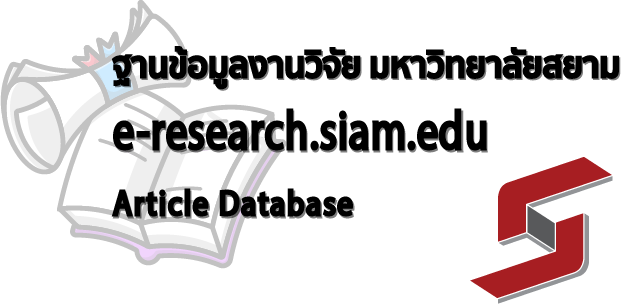- KB Home
- หลักสูตรปริญญาตรี|Bachelor Degree
- คณะเภสัชศาสตร์
- การใช้ยาลดระดับน้ำตาลในผู้ป่วยโรคไตเรื้อรัง ตามแนวทางเวชปฏิบัติสำหรับการจัดการเบาหวานในผู้ป่วยโรคไตเรื้อรัง; อ้างอิงตาม Kidney Disease: Improving Global Outcomes (KDIGO) 2020
| ชื่อบทความ: | การใช้ยาลดระดับน้ำตาลในผู้ป่วยโรคไตเรื้อรัง ตามแนวทางเวชปฏิบัติสำหรับการจัดการเบาหวานในผู้ป่วยโรคไตเรื้อรัง; อ้างอิงตาม Kidney Disease: Improving Global Outcomes (KDIGO) 2020 |
| Research Article: | Anti-hyperglycemic Therapies in Patients with Diabetes Mellitus and Chronic Kidney Disease; Based on the Kidney Disease: Improving Global Outcomes (KDIGO) 2020 |
| Author: | บุศยา กุลบุศย์ และ วีรชัย ไชยจามร | Busaya Kulabusaya and Weerachai Chaijamorn |
| Email: | weerachai.cha@siam.edu |
| สาขาวิชา|คณะ: | คณะเภสัชศาสตร์ มหาวิทยาลัยสยาม กรุงเทพฯ 10160 |
| Department|Faculty: | Faculty of Pharmacy, Siam University, Bangkok 10160 |
| Published|แหล่งเผยแพร่: | วารสารอายุรศาสตร์ มหาวิทยาลัยขอนแก่น ปีที่ 7 ฉบับที่ 3 กรกฎาคม – กันยายน พ.ศ. 2564 | KKU Journal of Medicine Vol.7 No.3 (2021) July – September 2021 Page.1-11 |
การอ้างอิง|Citation
บุศยา กุลบุศย์ และ วีรชัย ไชยจามร. (2564). การใช้ยาลดระดับน้ำตาลในผู้ป่วยโรคไตเรื้อรัง ตามแนวทางเวชปฏิบัติสำหรับการจัดการเบาหวานในผู้ป่วยโรคไตเรื้อรัง; อ้างอิงตาม Kidney Disease: Improving Global Outcomes (KDIGO) 2020. วารสารอายุรศาสตร์ มหาวิทยาลัยขอนแก่น, 7(3), 1-11.
Kulabusaya B. & Chaijamorn W. (2021). Anti-hyperglycemic Therapies in Patients with Diabetes Mellitus and Chronic Kidney Disease; Based on the Kidney Disease: Improving Global Outcomes (KDIGO) 2020. KKU Journal of Medicine, 7(3), 1-11.
บทคัดย่อ
โรคเบาหวาน และการมีระดับน้ำตาลในเลือดสูง เป็นหนึ่งในสาเหตุหลักที่ส่งผลให้ผู้ป่วยมีการทำงานของไตแย่ลง เกิดโรคไตเรื้อรังและนำไปสู่โรคไตเรื้อรังระยะสุดท้าย นอกจากนี้ยังส่งผลให้เกิดภาวะแทรกซ้อนทางโรคหัวใจและหลอดเลือดอีกด้วย ในปี พ.ศ. 2563 Kidney Disease: Improving Global Outcomes (KDIGO) ได้ออกแนวทางแนะนำการจัดการเบาหวานในผู้ป่วยโรคไตเรื้อรัง โดยแนะนำถึงเป้าหมายระดับน้ำตาลสะสม (hemoglobin A1C; HbA1C) ในช่วงน้อยกว่าร้อยละ 6.5 ถึงน้อยกว่าร้อยละ 8.0 และแนะน้ำให้เลือกใช้ยา metformin ร่วมกับยาในกลุ่มที่ออกฤทธิ์ยับยั้ง sodium-glucose cotransporter 2 (SGLT2 inhibitors) เป็นทางเลือกแรกในผู้ป่วยโรคไตเรื้อรังที่เป็นเบาหวานและมีค่าอัตราการกรองของไตมากกว่าหรือเท่ากับ 30 มิลลิลิตร/นาที/1.73 ตารางเมตร สำหรับผู้ป่วยที่ยังไม่ได้ระดับ HbA1C ตามเป้าหมาย หรือมีข้อห้ามใช้ยากลุ่มดังกล่าว ให้พิจารณาเลือกใช้ยาลดระดับน้ำตาลในเลือดกลุ่มอื่นโดยพิจารณาจากปัจจัยต่างๆ เช่น ความพึงพอใจของผู้ป่วย ค่าการทำงานของไต และราคายา ในบทความนี้ได้ทบทวนการใช้ยาลดระดับน้ำตาลในเลือดในแต่ละกลุ่ม รวมถึงข้อควรระวัง การติดตามผลการรักษาและอาการไม่พึงประสงค์ เพื่อให้สามารถเลือกใช้ยาที่เหมาะสมในผู้ป่วยโรคไตเรื้อรังแต่ละราย นอกจากจะช่วยควบคุมระดับน้ำตาลได้ตามเป้าหมายแล้ว ยังช่วยในการชะลอการดำเนินไปของโรคไตเรื้อรัง และช่วยลดภาวะแทรกซ้อนทางโรคหัวใจและหลอดเลือด
คำสำคัญ: ยาลดระดับน้ำตาลในเลือด, โรคไตเรื้อรัง, โรคเบาหวาน
ABSTRACT
Diabetes mellitus is one of the major causes of a decline in kidney function, and a leading cause of end-stage kidney disease and cardiovascular complications. In 2020, Kidney Disease: Improving Global Outcomes (KDIGO) publishes a clinical practice guideline for diabetes management in patients with chronic kidney disease. The target of hemoglobin A1C (HbA1c) level in the range between less than 6.5% and less than 8.0% is recommended depending on an individual patient characteristic. The combination of metformin and sodium-glucose cotransporter 2 inhibitors, is suggested as the first-line treatment in patients with glomerular filtration rate (GFR) greater than or equal to 30 ml/min/1.73 m2. If the patients are not able to achieve the HbA1c target or have contraindications to the aforementioned combination. Other glucose-lowering agents may be considered to lower blood sugar levels based on factors, such as patient preferences, GFR, and drug cost. In this article, we intended to review each anti-hyperglycemic agent used in clinical scenarios in terms of drug selection, precautions/contraindications, and monitoring of efficacy and adverse reactions. Moreover, appropriate use of glucose-lowering agents can help to attain the HbA1c target, slow down renal disease progression, and reduce complications associated with cardiovascular disease.
Keywords: glucose-lowering agents, chronic kidney disease, diabetes mellitus.
Anti-hyperglycemic Therapies in Patients with Diabetes Mellitus and Chronic Kidney Disease; Based on the Kidney Disease: Improving Global Outcomes (KDIGO) 2020
คณะเภสัชศาสตร์ มหาวิทยาลัยสยาม | Faculty of Pharmacy, Siam University, Bangkok, Thailand


